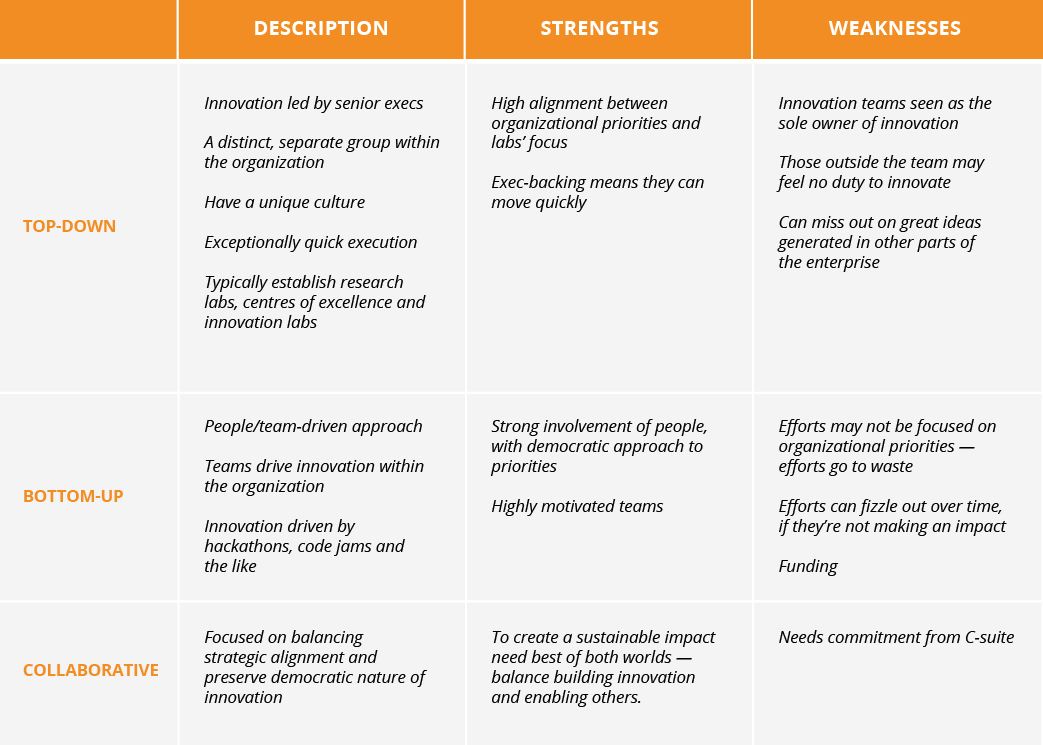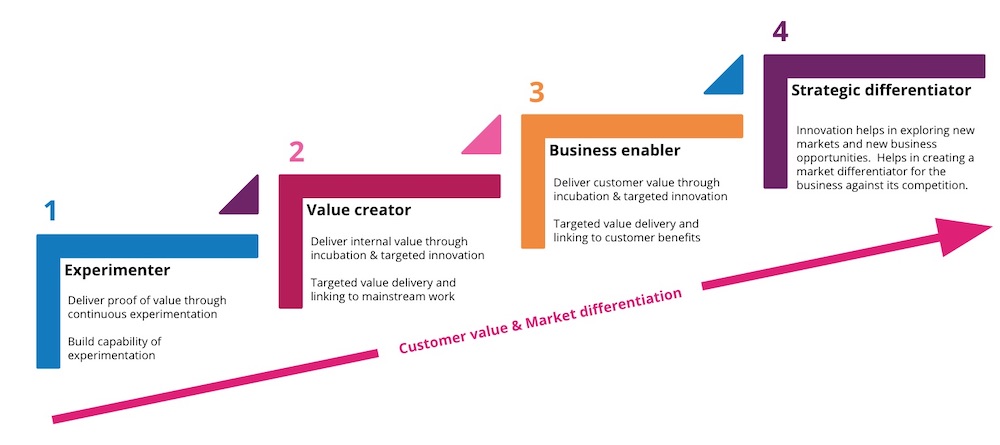Don’t wait for tomorrow
In the always-on, digital economy change happens fast. Any business that rests on its laurels can expect to become obsolete. In an ultra-competitive market, you have only a small window to spot opportunities and exploit them before your competitors. That’s because no matter how fast your market is evolving, technology is evolving faster.
Tech-led, innovative disruptors are everywhere. Just look at long-established markets like global commodity trading. Within three months of launching, VAKT ($), the blockchain-based energy trading platform had signed up more than two-thirds of companies responsible for all deals in North Sea crude oil trading.
This pace of change is unprecedented. And the consequences are clear:
Unless your organization is geared up to innovate, you’ll always be playing catch-up.
Many established organizations are comfortable not being at the bleeding edge. And that’s understandable: in febrile times, taking time to come up with a measured response can seem the pragmatic thing to do.
In fact, pragmatism shouldn’t be conflated with inaction. If you really want to understand the best course for your business, you need to understand it from a cost perspective. How much will exploring disruption and investing in innovation cost? What value can you derive from exploiting opportunities? What is the cost of missed opportunity? What will you have to spend to get back in the game?
And in many cases, that means you need to take action now. As Forrester Research principal analyst James Staten notes: “Driving change is far better and less fearful than waiting for others to disrupt you and having to painfully respond and adapt.”
Introducing the ‘innovate to impact’ framework
Concepts such as innovation can become overused, with everyone adopting slightly different ideas about what they mean. In this context, I’d define innovation as:
Creating something new, that generates a tangible value to the intended audience.
The most salient points here are “new” and “tangible value”. If it’s not new, and if it’s not bringing tangible value, it’s not innovation.
It’s worth noting at this point that one-off innovation isn’t really much use. Take pic sharing trailblazer Snap. Its clever use of AR tech briefly made SnapChat the must-have app for any social media-loving teen, paving the way for an IPO that valued the company at over $30 billion. But its innovations were easy for competitors, such as Facebook-owned Instagram to copy — over the months following the IPO, Snap’s market cap dropped by more than $20 billion. Snap has only subsequently been able to recover lost ground through embracing the ideas of continuous innovation.
To those that see innovation through the lens of eureka moments — where advances are only made after flashes of inspiration and brilliance — continuous innovation can appear anachronistic. It’s like capturing lightning in a bottle. This isn’t a view I subscribe to, but it’s one I’ve often encountered; therefore, before we start thinking about a roadmap for innovation, it’s worth considering some of the major obstacles you’ll need to overcome before any innovation program can get off the ground.
Barriers to innovation
Ask any business leader you encounter and they’ll say being more innovative is highly desirable. But for innovation to be something more than a pipe dream, you need to be realistic about the challenges you’re likely to face.
While there could be many reasons why innovation programs fail to take off within the organization, the most common barriers I have encountered are:
Fear of failure
In a world of performance reviews and targets, nobody wants to be associated with failure. When people are in fear for their livelihood they can become risk averse. What’s more, innovation means change — and change can be scary.
Being ready to innovate often demands a huge cultural shift, where experimentation is embraced. And if things don’t work, what’s important is what you’ve learnt from the experience; not who’s to blame.
Too busy on BAU
You’re probably used to hearing from your teams how busy they are. But when all your efforts are expended on keeping the lights on, your ability to innovate suffers. And since people are busy, they often feel that they’re adding value — perhaps without questioning whether they could add more. The importance any organization attaches to innovation has profound cultural implications. It’s all very well making grand gestures, such as setting aside regular time for blue sky thinking; but if those sessions are the first thing to be cut when cost savings need to be made, don’t be surprised if your staff question your commitment to innovation.
Lack of diversity
As author Simone Bhan Ahuja notes, lack of diversity within innovation teams can hamstring your efforts from the outset: “You’ll know you have the wrong team when everything is running along smoothly but the team’s output doesn’t look much different from business as usual.”
If you’re looking for new approaches and ideas, you’re going to need diversity of thought — people with different skill sets, people that come at problems from different angles. Key skills for the group may include: product strategy; product development; entrepreneurship; domain expertise; experience design; research and analysis; and ideation and creation.
Typical approaches to innovation?
Given the importance attached to innovation, it’s little wonder that so many people in the organization want to lead it. And while it doesn’t pay to be too prescriptive — each organization is unique and needs to find an approach that fits — here are some common approaches, along with their pros and cons.


As we’ve seen earlier, this collaborative approach will need team members with a diverse set of skills. And it also has the greatest opportunity to succeed when it involves the tech function. That’s because today’s greatest innovations are dependent on tech; the complexities and processes needed to deliver innovation reliably depend on tech expertise.
But collaboration also needs checks and balances: who is the one deciding on whether to focus on building something or enabling innovation? When should you focus on products and when is it more important to energize the team through events such as hackathons? Ultimately, you’ll also want to consider how you plan to support sustained innovation over the long term.
This isn’t something you can achieve overnight. Planning for continuous innovation is a journey — and one, if done right, that will become a strategic differentiator against the competition for years to come.
We call this journey the Impact to Innovation framework.


This Innovate to Impact framework gives you a roadmap to create internal incubator teams, that become the engine of your innovation. The framework also sets out how to grow the impact inside and outside of your organization through scaling different stages of maturity.
As the model suggests, for innovation to become a strategic differentiator, you cannot just stay at the experimentation level: you need to show the impact of innovation and have a plan to grow that.
It can be useful to think about this journey at the outset: Stage four becomes your blue ocean; you have to think about how innovation can become a strategic differentiator for your business and work backwards from there to identify what steps to take now.
In subsequent articles ( Part Two, Part Three and Part Four), we’ll explore this maturity model in more detail, enabling you to understand where you are today and how to reach your desired end-state.















